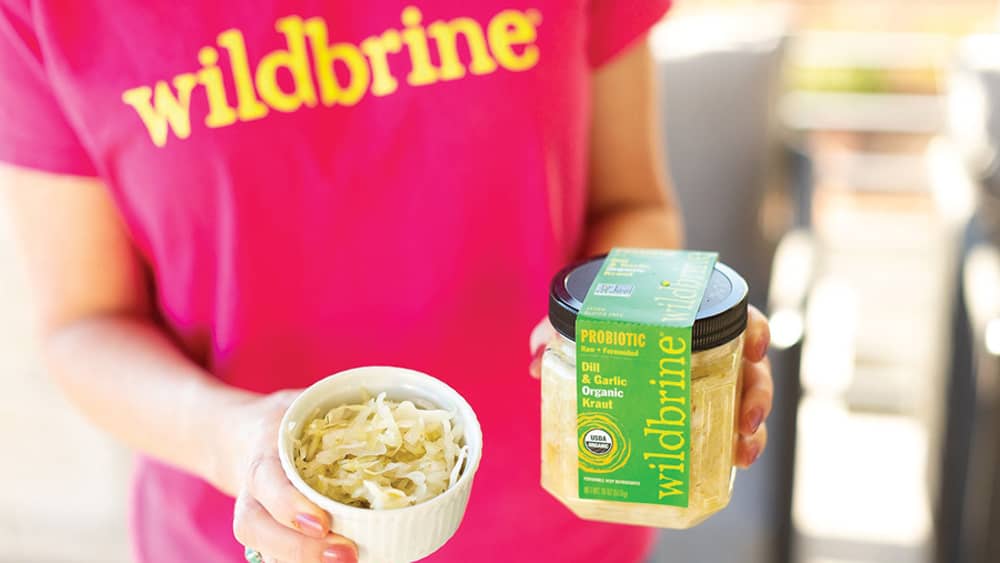
While it seems as though the fermented-food trend is on the rise, it’s not a new craze. In fact, fermented foods have been a staple in cultures and civilizations around the world, originally developed to preserve food long before the days of refrigeration. In Asia, Kimchi and Miso are fermented staples; in Germany, sauerkraut; tempeh from Indonesia; and even the Hawaiian food paste made from taro root, poi.
The cultural incorporation of fermented foods has brought these popular, healthy items to markets and dinner tables in the North Bay. Local companies are producing crave-worthy krauts, crunchy kimchis and flavor-packed pickles that are sure to be a guilty pleasure by the mouthful, if they aren’t already, with endless benefits for the body.
Breaking down the benefits
“The key factor in food choice is taste, and what’s great is all cultures have fermented foods that can appeal to different tastes,” says Linda Shiue, M.D., who specializes in internal medicine. She is also the director of culinary medicine at Kaiser Permanente San Francisco. “The modern American diet doesn’t include enough fermented foods,” she adds. “The key element is to look for probiotic-containing foods is live cultures. If they don’t contain live cultures, they don’t have the health benefits.”
Organisms found in fermented foods that are good for the gut include bacteria and different forms of yeast, she explains, and when they encounter food in the gut, they aid digestion by breaking down complex carbohydrates, which are sugar and starches. “Probiotics increase the ratio of good (meaning helpful) to bad bacteria in the gut,” says Shiue. “These good bacteria lower the pH in the gut, which can help fight off bad bacteria, as well as aid in the prevention of chronic diseases like obesity, autoimmune diseases, asthma and inflammation, which is thought to be related to cancer, heart disease, diabetes, mood disorders and possibly Alzheimer’s disease.”
“In brain health, we try to maximize our serotonin, (a key hormone in mood stabilization and happiness),” she says. “More than 90% is produced in our gut—not our brains. The most important thing is to make sure you have a healthy gut with good bacteria—it’s crucial.”
It’s also never too late to make positive changes in your gut health and increase the good bacteria in your body. Known as the microbiome, it’s a community of microorganisms in the body. “The fascinating thing is, depending on how you eat, you can have an effect on your microbiome within five days. You’re not stuck with your bad gut, and it’s never too late—you can improve it at any time.”
But beware of going overboard with dietary changes, and be sure to include variety when incorporating probiotics and prebiotics, found in fiber-rich foods, into your diet. “The stomach doesn’t like too much change at once,” says Shiue. “It’s the same with probiotics. There are so many choices, and variety is a good idea because different fermented foods have different good bacteria.” In yogurts, she says, there are usually two to four live cultures, but in most kefir (fermented dairy drink), there are at least 10 or 20 more.
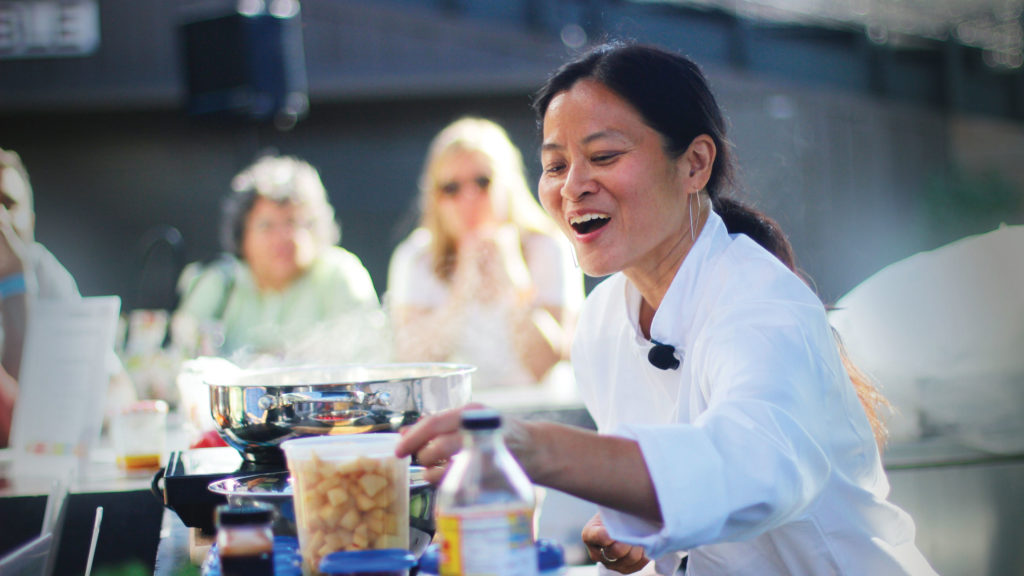
Balance is key, and the addition of a prebiotic is also critical in getting maximum benefits to the body.
“Use balance,” says Shiue. “People can’t just eat fermented food all the time. Prebiotics are vital because they encourage the growth of healthy gut bacteria.” Prebiotics can be found in a wide variety of fruits and veggies, she explains, and incorporating them into your diet can lead to better gut health while decreasing inflammation.
“A lot of people like to take a pill for things, such as a probiotic,” says Shiue. “Some have benefits, especially ones that specialists prescribe to people in specific disease states, but unfortunately, over-the-counter probiotics might not have the same effect. The question is whether they survive the digestive process. Supplemental probiotics that aren’t tied up with foods don’t have protection. The key is they are meant to be alive, and that’s why they are so sensitive.”
For Shiue, it’s all about prevention, and she’s at the forefront of helping the community by educating on the importance of diet and nutrition through her programs offered through Kaiser, where she teaches healthy-cooking classes monthly. “Thrive Kitchen is open to anyone in Kaiser for free,” she says. “I focus on cooking because people eat food, not nutrients.”
wildbrine
The first question wildbrine proprietors Rick Goldberg and Chris Glab ask themselves when tasting their products is this: Does it taste good? And no doubt, their loyal enthusiasts are answering that question with mouthfuls of flavorful sauerkraut, saying, “Yes!”
Locally owned and operated, wildbrine’s 30,000-square-foot facility on Bellevue Avenue in Santa Rosa produces sauerkraut, kimchi, sriracha and salsa. And at the company’s new 21,000-square-foot facility on Industrial Drive in Santa Rosa, the company produces its wildCREAMERY plant-based dips and dairy alternative products, which are sold in the North Bay, as well as across the U.S., Canada, Japan and even in Korea.
“Fermentation is a magical process, with huge benefits,” says Glab. One of the obvious benefits is the outcome of wildbrine’s delicious sauerkrauts, with flavors such as dill and garlic, caraway apple and jalapeño lime. Zesty, flavor-packed with the perfect amount of crunch, these krauts are easily enjoyed by the spoonful.

During their fermentation process, the product never goes beyond 70 degrees, which is the perfect fermenting temperature, according to Glab. They then refrigerate it and keep it cool.
He and his business partner, Goldberg, are “culinary curious,” as Glab puts it. “We saw the trend of plant-based and thought, ‘What makes plant-based dairy taste the way it does? It’s fermentation.’”
Aside from their sauerkrauts and kimchis, wildbrine produces a wildCREAMERY line with a dairy-free butter alternative, dairy-free sour cream and even dairy-free brie alternative from their wildCREAMERY line. Ingredients include coconut oil, water, sunflower oil and cashews.

“Traditional European style is cultured,” Glab explains. “That’s the product of lactobacillus fermentation—the same organisms that ferment milk to make dairy butter and cheeses. But, how can we use our organisms and ferment plants and dial that into a culture that we add to plant-based ingredients like nutritional yeast and butters and sour creams? We were blown away by how close they were to dairy flavors.”
Wildbrine products are available nationwide in specialty stores, including Whole Foods, Sprouts, Safeway and Costco. The company launched wildCREAMERY in early 2021. Shoppers can look for increasing availability of these products in their local grocery stores.
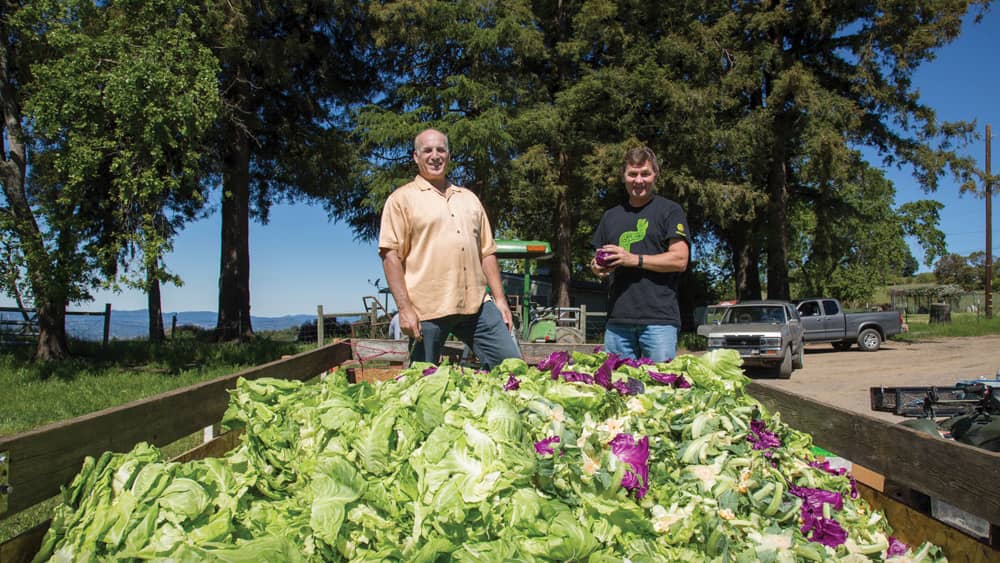
Going crazy for kefir
What’s better for you than most yogurts, high in nutrients and probiotics and all the rage in the health community? Kefir. The fermented drink, made from cow or goat milk, uses kefir grains, containing yeast and lactic acid, which multiply and ferment the milk sugars, ultimately turning it into the drinkable liquid, or in this case, a delicious cheese.
At Achadinha Cheese Company in Petaluma, owners Jim and Donna Pacheco take their love of kefir and sell it at local famers markets for all to enjoy. “I love yogurt—always have,” says Donna. “With a good granola, a little goes a long way.” Discovering the health benefits of kefir, Pacheco began her own research and development to make her own kefir. “I started doing research because of active bacteria,” she says.
Their friends at Dairy Connection, Inc. in Wisconsin helped them with the process. “I made it on my stove and it turned out okay,” Donna explains. “Then, we made it in a bigger process, using one cup organic sugar per 40 pounds of kefi.”
Though grains can be used to make kefir, the Pachecos use culture. “To do it on a commercial level, we have to use fresh cultures each week,” says Donna. “We pasteurize the milk, then we have it in 32-gallon drums.” Pacheco maintains the temperature by placing water and ice on the outside of the drums. The all-day process has Pacheco using absolute precision, tracking her kefir through the evening. “Kefir is inoculated at 79 degrees,” she says. “I use fresh culture each week so I can track each batch. We then add the bacteria to the 32 gallons and reach a temperature of 79 degrees. Next, we add the water around the drums.”
At around 8 p.m., Donna heads back out to the cheese plant to check her temperatures again, and in the morning, it’s gelled up to a gelatin consistency. “We carefully scoop it and place it in nylon bags so it can drain. On the following day, it’s drained, and we mix the sugar, which keeps it from getting over firm,” she says.
The Pachecos kefir cheeses are flavored with local, in-season fruits each week. “We do two flavors each week,” she says. “Whatever we have access to. And I don’t do multiples, because it’s easier for us to rotate and keep track of.”
Popular flavors include Bavarian and raspberry, and apricot and lemon. “We started doing fruit because people started asking for it,” she says. “We only do plain for an aligned amount of markets, and I only do what sells that week because I don’t want it sitting.”
The Pachecos supply farmers markets with their popular kefir cheese. “We make 500 containers a week,” she says. “Now, we do 47 farmers markets a week in the Bay Area and we have someone running five farmers markets in southern California.”
The farmers markets have saved our tail, says Donna, during the trying times of running a cheese company during a global pandemic. “It has worked out well,” she says. “We can maintain control of the product in farmers markets. If the kefir is not sold at the farmers market within a week and a half, it’s pulled. Once a consumer takes it home, it’s good for two weeks.”
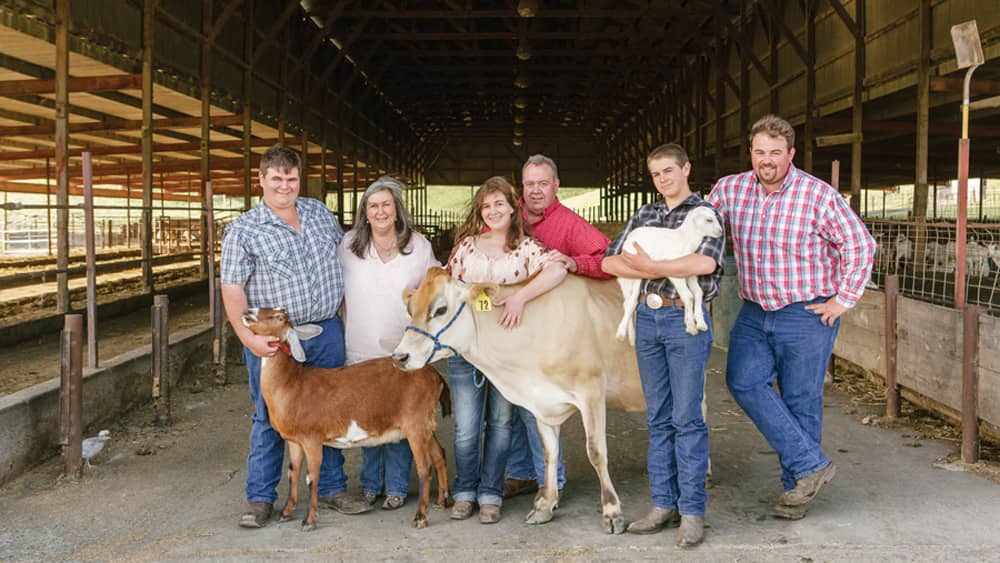
“We feed brewer grain back to the girls on top of the whey,” says Donna. The Pachecos even use bacteria from their own kombucha to the whey trough. “The girls are eating the fermented whey, which has extra fermentation.”
In response to her cows eating a nutrient-rich diet, the products made from their milk are that much better in quality, and their patrons notice the difference. “People are starting to pay attention,” she says. It’s important for us to know where our food is coming from, and more and more people want to know where their food is coming from.”
That’s the advantage of Achadinha Cheese Company, which offers scheduled tours for visitors to come in and see for themselves. “Not many farms are opening up and allowing people to come through,” Donna says. “Visitors get to see the equipment used to milk the girls, walk through the cheese plant, see the molds on the cheeses, the process, the dairy, the breeding, and even go in the barn and see the girls. I wasn’t raised in this environment and I like seeing and sharing this.”
“We hand raise all our animals, so they’re not nervous around people. They’re not producing cortisol, which is better for the food they produce for consumers,” she says. Nervousness or fear in cows typically results in cortisol production, which can have an effect on their milk and other foods made from their milk. “I love that all of our meat is raised on the property—and knowing how the animal is being raised and treated and fed. That’s the movement.”
Sonoma Brinery
As a child, David Ehreth, owner of Sonoma Brinery in Healdsburg, acquired a passion for the pickle, but not just any pickle. “My father introduced me to the New York-style kosher pickle,” says Ehreth, who grew up in Marin, but his father and grandfather were originally from New York. And the Kosher pickle, native to New York, seemed impossible for him to find later in life west of the Hudson River.
“I fell in love with this pickle as a kid,” he says. “Later in life, I figured out that it was fermented, not treated with vinegar, and that fermentation was key to this pickle’s unique flavor and texture. All fermentation and no vinegar makes this truly the ‘King of Pickles.’”
He started Sonoma Brinery in 2004, setting out to make the perfect fermented kosher pickle.
“When I started the company, we made two pickles: Manhattan-style whole koshers (fermented) and Outrageous Bread & Butter Pickles (vinegar brine),” he says.
“In 2005, I started making sauerkraut. At the time, nearly all sauerkraut was pasteurized [dead]. Our sauerkraut was the first live-culture, fermented sauerkraut to appear in standard grocery stores. Combined with our fermented kosher pickle, we pioneered the market for live-culture, fermented vegetable products. Years later, there are dozens of ‘follow-on vendors’ and a whole food category has been created.”
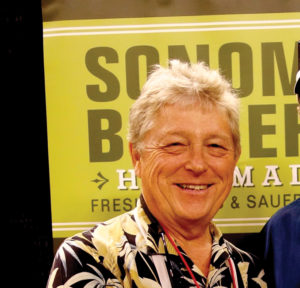
“One of the charming features of fermented foods is that while they all taste good, there are subtle differences from batch to batch just as there are in the wines, year over year. All of the bacteria in our products are regarded as not only safe, but some scientists believe that our bodies need this influx of biology to live a healthy life.”
Aside from their perfected kosher pickles, Sonoma Brinery also makes Raw Slaw Curtido and Jalapeño Escabeche (fermented), meaning “marinated item,” and raw sauerkrauts. “The Manhattan-style whole kosher remains the most popular of all of our products,” says Ehreth. “A true fermented kosher ‘half-sour’ [still looks like a cucumber on the inside] is something that’s hard to improve on.”
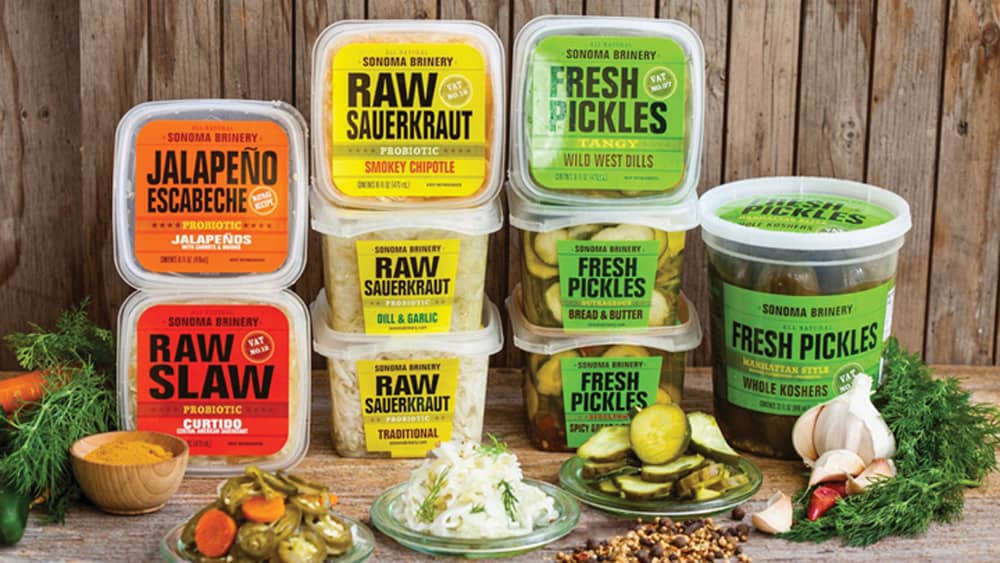
Their newest development on the horizon is their new 23,000-square-foot production facility in Santa Rosa, which should be up and running by the first quarter of 2022. Sonoma Brinery’s products are available at Safeways, Oliver’s, Whole Foods and other grocery stores locally and around the West Coast.
8 Fermented Foods from Around the World
Chances are you’ve heard of these popular fermented food products that originated in other parts of the world. In fact, you might already enjoy them alongside some of your favorite foods and don’t even notice.
Kefir. A cultured dairy product made from kefir grains made up of a combination of yeast and bacteria to milk. The thick and milky beverage is reminiscent of yogurt, with at least double the benefits. Containing less lactose than milk, it’s easy to digest and its consumption has shown to aid in a decrease in chronic disease.
Tempeh. Made from fermented soybeans, this Indonesian cake-like meat substitute is high in protein and contains antioxidants.
Natto. A Japanese fermented soybean product, natto is high in fiber and has been known to aid in the prevention of bone loss.
Kombucha. A popular fermented tea, this fizzy drink is packed with benefits, and can possibly reduce blood pressure while reducing cholesterol.
Miso. A Japanese seasoning made by fermented soybeans. Associated with heart health and reducing certain cancers.
Kimchi. A popular Korean side dish made from fermented cabbage and other vegetables. May help reduce insulin resistance and cholesterol.
Sauerkraut. A German dish, consisting of fermented shredded cabbage by lactic acid bacteria. High in antioxidants and important for eye health.
Probiotic yogurt. Fermented milk using lactic acid bacteria containing probiotics along with calcium, potassium, riboflavin and vitamin B12.
Source: healthline.com



